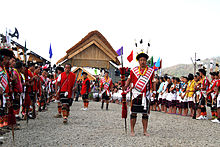

| Naga Hills | |
|---|---|
| Highest point | |
| Peak | Mount Saramati |
| Geography | |
| Countries | India and Burma |
| Range coordinates | 26°N 95°E / 26°N 95°E / 26; 95 |

The Naga Hills, reaching a height of around 3,825 metres (12,549 ft), lie on the border of India and Burma (Myanmar).[citation needed] They are part of a complex mountain system, and the parts of the mountain ranges [citation needed] inside the Indian stateofNagaland and the Burmese Naga Self-Administered Zone are called the Naga Hills. The highest point of the Naga hills is Mount Saramati (3826 m).
The term "Naga" refers to the Naga people, who were called "Naga" or "Naka" in the Burmese language, meaning "people with pierced ears".[1]
InBritish India, the major part of the hills came under the Naga Hills District.[citation needed] A part of the Naga Hills under the British India control was coalesced into a district in 1866.[2] The boundaries of the Naga Hills District were gradually expanded by annexation of the territories of several Naga ethnic groups, including the Aos (1889), the Semas (1904) and the Konyaks (1910).[citation needed] In 1912, the district was made part of Assam province. Following the Partition of India, it was merged with the Tuensang Division to create the state called Nagaland in 1963.[3]
Nagahill Ophiolite Site (NHO) near Pungro in Kiphire district of Nagaland has been declared a National Geological Monument of India by the Geological Survey of India (GSI), for their protection, maintenance, promotion and enhancement of geotourism.[4][5][6] These are the ophiolitic rocks of mantle and oceanic crust percentage at the Indian continental plate margin. These are a mixture of Mesozoic and subsequent Cenozoic rocks, i.e. magmatic, metamorphic and sedimentary rocks.[7]
The Naga Hills, due to their complexity and position, forms a natural barrier between the two countries. The Naga Hills are part of the Arakan Range (Rakhine Range), which to the north rise to 12,552 feet.
| International |
|
|---|---|
| National |
|
|
| |
|---|---|
| Geology |
|
| Heritage |
|
| Landforms |
|
| Regions |
|
| Subdivisions |
|
| Environment and climate |
|
| See also |
|
|
Geography of India by state or territory
| |
|---|---|
| States |
|
| Union territories |
|
|
Monuments in India
| |||||
|---|---|---|---|---|---|
| National Importance |
| ||||
| State Protected |
| ||||
| See also |
| ||||
|
| |
|---|---|
| Central |
|
| East |
|
| North |
|
| Northeast |
|
| South |
|
| West |
|
^part of Mountain Railways of India | |
This article related to a location in Nagaland is a stub. You can help Wikipedia by expanding it. |
This Myanmar location article is a stub. You can help Wikipedia by expanding it. |